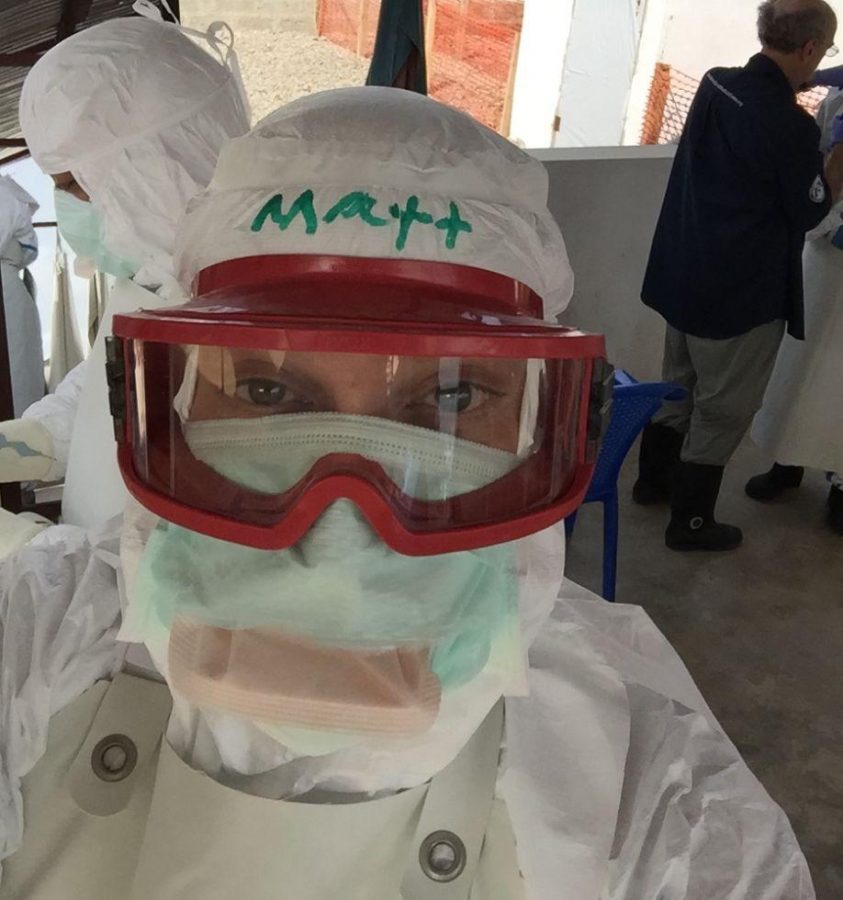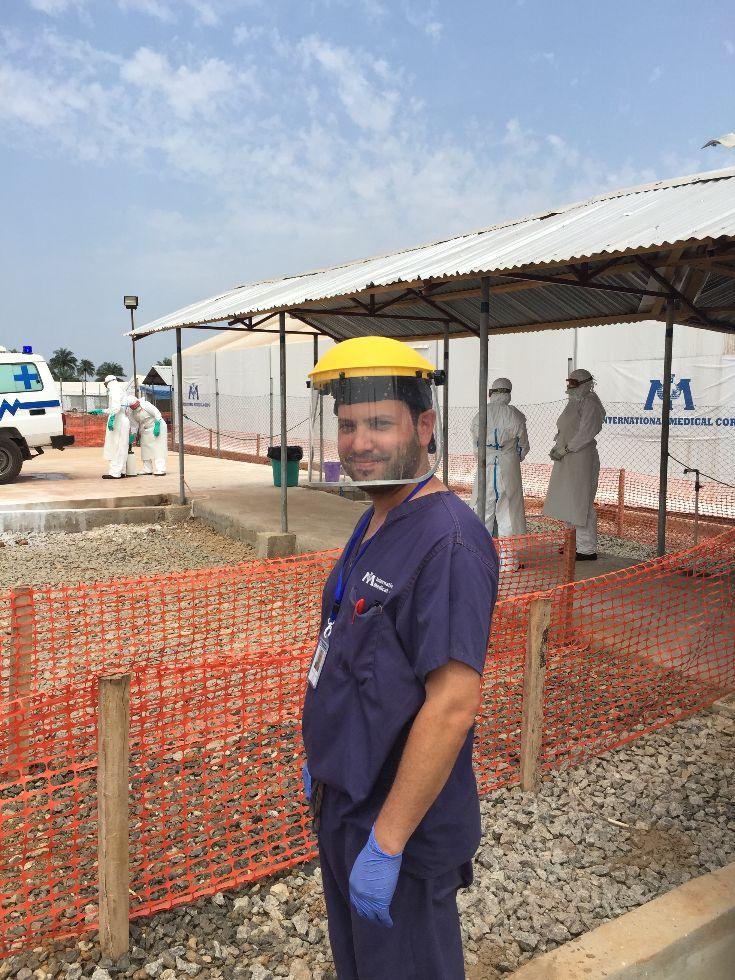Every day, in a “sacred and very deliberate ritual,” Matthew Waxman ’92 put on a mask, then a hood and two layers of gloves that were duct-taped closed in order to prevent any fluids from getting inside. He then placed a heavy apron over his chest, and finally, a plastic face shield was fitted over his face. By the time he was dressed, he was already drenched in sweat.
Waxman, an associate professor of emergency medicine at University of California Los Angeles, volunteered as a doctor in an Ebola treatment center in Lunsar, Sierra Leone from the end of December last year to the end of February this year, during the height of the Ebola epidemic.
“The heat made it impossible for us to stay in the treatment tent for too long,” Waxman said. “So we had to move quickly. We didn’t want to dilly dally and waste precious time.”
Once the suit was on, someone would write the name of the doctor or nurse and the time he or she entered the tent in dry erase marker on his or her suit. This process helped to keep track of the number of minutes the individual had been in the treatment center. The doctors always entered the tent in pairs and attended to a certain number of patients that they had planned to attend to beforehand. They ran IV drips and tried as best as they could to entertain the sick children.
“There wasn’t really much we could do for the sickest patients,” Waxman said. “All we could do was to make sure that they were comfortable. Ebola is an emotionally trying disease to deal with. Only 62 percent of the patients that came into our ward survived. No child under the age of five survived. It was very difficult to come to terms with the deaths at first.”
Before departing for Sierra Leone, Waxman had a “healthy respect for the disease” but didn’t know exactly what to expect. He cites educational purposes as well as personal interest for working as a doctor in an Ebola treatment center during the height of the Ebola epidemic.
“When Ebola broke out, I was on a panel at UCLA, and I realized that no one on the panel really knew that much about Ebola,” Waxman said. “So I looked into going [to Sierra Leone]. Infectious diseases have also always been my first love, interest-wise, so I really felt compelled to volunteer at some place where I could be of benefit to world health.”
Waxman said the place where he worked in Sierra Leone looked like Guantanamo. He said that the treatment center was ringed in barbed wire and that there were huge shipping containers. Waxman and his colleagues worked in tents set up by the United Nations and slept in a guesthouse “in town.”
As a medical officer for the International Medical Corps, a typical day for Waxman began with peanut butter on bread and a cup of instant Starbucks coffee. He and other doctors and nurses were driven to the compound, where they had to show identification and go through security. There they replaced the people that were at the end of their shift and began their own 12-hour shift.
Everyone was required to dunk their shoes into bleach then change into scrubs and rubber boots. Once changed, the rubber boots were sprayed with bleach before the medical personnel were permitted to enter the medical tent.
“We actually spent only a very small portion of our shift in the treatment tent,” Waxman said. “This is because our time in the suits was limited due to the heat. It was over 100 degrees every single day, and we were wearing extremely heavy gear. We did do a lot of paperwork in a separate medical tent.”
In the medical tent, doctors reviewed the patients’ records from the previous shift and planned out the course of action for the next 12 hours. They then made rounds of non-Ebola patients, began to work on paperwork and ordered medications for the following shift of doctors to administer to the patients.
The first time in their day that the doctors encountered the Ebola patients was in what Waxman called “fencing.” The Ebola patients who were able to walk stood behind a fence that surrounded their treatment center while doctors stood 10 feet away from the patients on the other side. From there, the patients would be questioned on their physical state and their symptoms. When the doctors donned the suits, their main focus was on the patients who could not walk.
Due to the shortage of nurses, Waxman said that everyone had to do everything.
“Working in that treatment center was the most difficult task of my medical career because I had to do tasks that I wasn’t used to doing as a doctor in the U.S.,” he said. “In one instance, I remember holding a meal tray in one hand [and] trying to move the patient with the other while I was covered in Ebola blood and vomit.”
Waxman said that he was anxious the first time he entered the treatment tent, but the doctor who trained him to work in the treatment center had given him some words of wisdom that he remembers very clearly.
“I asked him, ‘is it okay to be anxious?’” Waxman said. “And he responded with, ‘the definition of courage is doing something you know is right even if you know you’re afraid.’ Those words have really stuck with me.”
When exiting the treatment tent, the medical personnel were continuously sprayed with highly concentrated bleach as they took off their suits.
Other than doing paperwork and treating the Ebola patients for a limited amount of time, the doctors also had to make decisions about whether or not to accept new patients into the unit.
“We had to ask questions like, ‘has there been a death in their family?’ or ‘are they running a fever?’” Waxman said. “We had to be careful, and some of the decisions were very difficult to make because we didn’t want to admit an Ebola-free patient into the treatment center and have them contract Ebola, but we also didn’t want to turn an Ebola-positive patient away where they would infect more people.”
Waxman believes that the Ebola scare in America was blown far out of proportion but also believes that it raised necessary and appropriate questions.
“I think that [the scare] was not based on science and evidence,” Waxman said. “My opinion is that for every American with Ebola, 5,000 Africans died. I think it’s important for Americans to understand that the lack of a public health system in Africa is what made Ebola an epidemic. There could not have been, in my opinion, a large-scale Ebola epidemic in the U.S. because we have a public health system. However, I do think that the Ebola scare that went through the United States definitely raised some questions about how we would deal with a large-scale infectious disease emergency. Part of my job before I went to Sierra Leone, was actually to prepare Los Angeles County for Ebola.”
Waxman said that the most memorable part of his experience was the camaraderie between his colleagues.
“I worked with people from Lebanon, from Sierra Leone, England, Ireland, Australia, and the bonds that we forged while working in the Ebola treatment unit was one of the highlights of my career so far,” he said. “There’s a myth about Ebola that a lot of the doctors were American volunteers, but that was hardly the case. They couldn’t find enough North American volunteers. There were some western doctors, but many of them were Indian, Pakistani and African physicians.”
After graduating from Harvard-Westlake in 1992, Waxman attended University of California Berkeley, and majored in philosophy. He then went to Central America for almost a year, where he discovered his passion for medicine. When he returned, he took extra pre-med classes at San Francisco State. Waxman attended medical school at the Albany Medical College and did his residency in internal and emergency medicine at UCLA. He joined the faculty at UCLA after graduation and trains residents in emergency medicine. He also works at Olive View – UCLA Medical Center.
Waxman also earned a degree in tropical medicine and hygiene in Lima, Peru, and is involved in teaching emergency medicine in Bangkok every year and teaches trauma management skills to medics in areas of conflict.
Upon his return to the United States from Sierra Leone, Waxman was quarantined for 21 days.
“A public health nurse checks in with Waxman twice a day — once over videoconference, once by phone — to monitor his temperature and symptoms,” according to the Los Angeles Times, in the article titled, ‘Isolation can take emotional toll on volunteers at risk of Ebola,’ published on Mar. 1, 2015. “As long as he does not have a fever of 99.5 degrees or higher or have any symptoms that could be early signs of illness, Waxman is allowed to care for his young child and to leave his house in Silver Lake for six hours until his next temperature check. He has gone grocery shopping and has walked his son to school.”
Waxman hopes to return to Sierra Leone later this year to work in the Ebola treatment center again.
“My first inclination when I got back to my house in Silver Lake,” he said, “was to go back to Sierra Leone.”


































